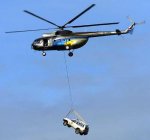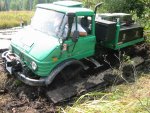You are using an out of date browser. It may not display this or other websites correctly.
You should upgrade or use an alternative browser.
You should upgrade or use an alternative browser.
Ultimate Recovery Gear Thread
- Thread starter Scott Brady
- Start date
Scott Brady
Founder
Great picture Graham! Oh, and a pulley block is on the list 
Mlachica
TheRAMadaINN on Instagram
There's no such thing as a stupid question right? What's a constrictor strap? Is it this?
What about adding proper lifting points for the hi-lift such as the lift mate and bumper lift? (there's plenty more to choose from if this doesn't suit your needs)
What about adding proper lifting points for the hi-lift such as the lift mate and bumper lift? (there's plenty more to choose from if this doesn't suit your needs)
Last edited:
Scott Brady
Founder
Mark,
Great Question
The constrictor strap I use is this one:
Extreme Outback Constrictor Strap

For jacking, Chris and I are testing this cool slider adapter from WABFAB

A very stout piece
Great Question
The constrictor strap I use is this one:
Extreme Outback Constrictor Strap

For jacking, Chris and I are testing this cool slider adapter from WABFAB

A very stout piece
91xlt
Adventurer
this is a pretty complete list, in addition i like the winch attachments from hi lift, not sure of the accessory name but it has the chains and hooks, this has been very useful a few times for me and i also have a mil spec recov strap for something like 30,000# thats 20' long also can be very useful.
expeditionswest said:Oh, and a pulley block is on the list
Just to be sure everyone is on the same page, a greasable pulley block is not necessarily a recovery snatch block. Don't use blocks intended for lifting as a snatch block for vehicle recovery, and remember that using a snatch block has the potential for doubling the rated pull of the winch, so the block needs to be able to handle at the minimum twice the rated pull of your winch. Spend the money and get one made for the purpose. Hard to find a better one that the one offered by ARB. I carry two, just in case.
Also keep in mind that adding blocks to a recovery generally requires more shackles than normal, and usually requires a tree saver. I don't recommend chain for attaching a snatch block to an anchor point. Carrying 2 or 3 shackles (as shown on the list) might not be enough for complex situations or multiple vehicle recoveries, and if you are like me, they get lost on the trail regularly, so having spares is a good idea.
One item not mentioned by anyone is a winch line damper. Seems that no one really uses these except in competition. I use one all the time. Canvas, Velco, and about 4 pounds of lead rope (flexible fishing weight material), sewn together in a mini poncho or saddle bag configuration. I wrap this around the winch line and secure it with two cable ties in a loose bundle so it slides readily on the line, but can't fall off. Position the weight about midpoint on the line once attached and ready to recover. Stop and move it back to center on really long recoveries. Remember to take tension off the line while repositioning the weight if this is possible, or at the very least, stop winching while moving the weight. Don't handle a live cable (under tension), and don't handle winch line at any time without gloves, even if using synthetic rope. Safe winching is like safe sex -- it might sound silly and boring, but it will save you a bunch of grief sooner or later.
Maybe our trails here in Alaska are different from other areas, but I have 160 feet of synthetic line on my 8274, and I generally carry an 80 foot extension, a 140 foot extension, and a spare 160 foot line with the thimble already spliced in and ready to go, in addition to a minimum of two 40 foot snatch straps, two tree savers, and one or two 10 foot cargo straps which do not stretch. For challenge racing, we carried something like 420 feet of extra synthetic rope in various configurations, all with thimbles spliced to the ends, and 4 snatch straps. It isn't often that I have had to use an extension, but there have been times when the nearest anchor point was way over 300 feet away.
ShearPin
Adventurer
Master Pull Kinetic Recovery Strap
I've had good luck with Kinetic recovery straps, although proper chasis mounted tow points are a must have and I take extra care to ensure no debris is stuck up under chasis and steering parts.
While I usually travel alone when I do go with someone it is most often my brother. My 2.25 powered Land Rover would struggle to recover either his H1 or Unimog 416 without one. The one I have is branded Masterpull - it was a gift from my brother three years ago. In mud especially - sometimes all it needs is that extra jolt.
To be honest, I've never used it on the Mog. When it gets stuck....
Henry
I've had good luck with Kinetic recovery straps, although proper chasis mounted tow points are a must have and I take extra care to ensure no debris is stuck up under chasis and steering parts.
While I usually travel alone when I do go with someone it is most often my brother. My 2.25 powered Land Rover would struggle to recover either his H1 or Unimog 416 without one. The one I have is branded Masterpull - it was a gift from my brother three years ago. In mud especially - sometimes all it needs is that extra jolt.
To be honest, I've never used it on the Mog. When it gets stuck....
Henry
Attachments
waskillywabbit
Observer
I vote for the WabFab Off-Road slider adapter for Hi-Lift Jacks as a GREAT addition to recovery gear!
:elkgrin:
:elkgrin:
Linus Tremaine
Adventurer
knots
How about a knot reference sheet? Or at least try to learn some important knots.
Try this:
http://www.animatedknots.com/index.php?LogoImage=LogoGrog.jpg&Website=www.animatedknots.com
learn the truckers hitch to help tie things down
bowline, alpine butterfly??
How about a knot reference sheet? Or at least try to learn some important knots.
Try this:
http://www.animatedknots.com/index.php?LogoImage=LogoGrog.jpg&Website=www.animatedknots.com
learn the truckers hitch to help tie things down
bowline, alpine butterfly??
Scott Brady
Founder
Linus Tremaine said:
That is the best knot site yet. Thanks for posting that!
mountainpete
Spamicus Eliminatus
Hi guys,
From my experience, I feel that one big component is missing. Coveralls and boots. Here's why:
As most people on the site know, I love flyfishing and a lot of my overland involves getting to backcountry lakes or other spots. Oftentimes I go wearing my fishing clothing, shorts, etc. And do you really want to get that new LL Bean Bug-Off shirt covered in mud? No!
So I always keep a pair of steel toed rubber boots and a set of coveralls in the back for those muddy recoveries. If I see a spot that looks like it might require recovery before I go into it (like a mud hole), I will slip on the boots and coveralls first. However, most of the time I end up using it to help recover other vehicles who tried to go a bit further then they should have.
The extra bonus is, once the recovery is done, the mud stays outside of the cab.
Pete
From my experience, I feel that one big component is missing. Coveralls and boots. Here's why:
As most people on the site know, I love flyfishing and a lot of my overland involves getting to backcountry lakes or other spots. Oftentimes I go wearing my fishing clothing, shorts, etc. And do you really want to get that new LL Bean Bug-Off shirt covered in mud? No!
So I always keep a pair of steel toed rubber boots and a set of coveralls in the back for those muddy recoveries. If I see a spot that looks like it might require recovery before I go into it (like a mud hole), I will slip on the boots and coveralls first. However, most of the time I end up using it to help recover other vehicles who tried to go a bit further then they should have.
The extra bonus is, once the recovery is done, the mud stays outside of the cab.
Pete
Forum statistics
Members online
- danneskjold
- Cas
- TommyG
- Bamagirlaz
- Luke Duke
- driller
- gavan
- Fenderfour
- Savagenut
- Power Wagon Family
- funshot
- sburks737
- RVflyfish
- 4runnerteq
- warrpath4x4
- ITTOG
- goawaymore
- Mekcanix
- driveby
- geovangelist
- matttahoe53
- saucer_boy
- Pacific Northwest yetti
- parabolD
- gator70
- Zmanfj40
- kirkdensmore
- Inspired Adventurist
- hoosier96
- Ties
- NOPEC
- jamiec
- MFinley
- fisher205
- RealRigsRattle
- OhioOverlander
- SootyCamper
- cacti
- Mac95
- GR8ADV
- Red90
- MatttheHatt
- BajaSurfRig
Total: 842 (members: 45, guests: 797)


